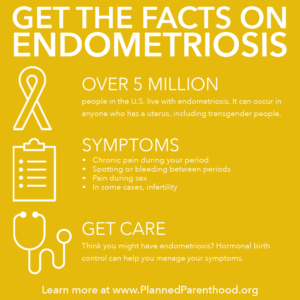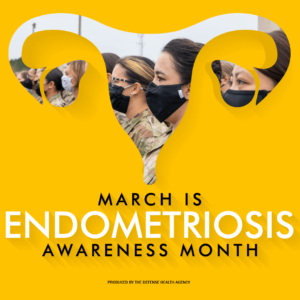Endometriosis Risk Factors:
Research shows that there are some things that put a person at higher risk of developing endometriosis, including having:
- A mother, sister or daughter who has endometriosis
- An abnormal uterus, which is diagnosed by a doctor
- Early menstruation (before age 11)
- Shorter menstrual periods (less than 27 days on average)
- Heavy menstrual periods lasting more than seven days
Some things that can lower the risk of endometriosis include:
- Pregnancy and breastfeeding
- Having your first period after age 14
- Eating fruits, especially citrus fruits
Endometriosis prevention:
Endometriosis is an idiopathic condition, meaning there is no known cause. There are also no specific ways to prevent endometriosis. However, being aware of the symptoms and whether you could be at higher risk can help you know when to discuss it with a doctor.
Endometriosis Stages:
Doctors classify endometriosis from stage 1 to stage 4. The stages are based on where endometrial tissue occurs in the body, how far it has spread and how much tissue is in those areas.
Having a more advanced stage of endometriosis does not always mean you will have more severe symptoms or more pain. Some women with stage 4 endometriosis have few or no symptoms, while those with stage 1 can have severe symptoms.
Endometriosis Treatment:
There is no lasting treatment for endometriosis, but doctors can offer treatments that help you manage it. Finding the right treatment depends on many different factors, including your age and symptoms. Doctors will also discuss whether you want to have children, which can help determine the best treatment options.
Nonsurgical endometriosis treatments
The most common treatments for endometriosis that do not require surgery are hormone therapy and pain management.
Endometriosis tissues are affected by hormones in the same way as endometrial tissues inside the uterus. Hormone changes that occur with a menstrual cycle can make endometriosis pain worse.
Treatments that include hormone therapy can alter hormone levels or stop your body from producing certain hormones. Hormone therapy can affect your ability to get pregnant, so it may not be right for everyone.
Hormone therapy can be taken as pills, shots or a nasal spray. The most common options include:
- Oral contraceptives with estrogen and progesterone to control hormones
- Progestins to stop menstrual periods and endometrial tissue growth
- Gonadotropin-releasing hormone antagonist to limit ovarian hormones
- Gonadotropin-releasing hormone agonist to stop ovarian hormones
Pain medications, including nonsteroidal anti-inflammatory drugs (NSAIDs) like ibuprofen, can be effective for managing endometriosis pain. A doctor can also discuss whether you need prescription medications for more severe pain.
Laparoscopy for endometriosis
Patients who have more advanced endometriosis, pain that does not resolve with other treatments or are trying to conceive may need surgery. Laparoscopy is the most common surgery doctors use to treat endometriosis.
During this procedure, a surgeon makes a few small incisions in your abdomen. In one incision they insert a thin tube with a light and a camera. In the other incisions they insert small tools. These tools can remove endometrial tissue (excision) or use intense heat to destroy the tissues (ablation).
The surgeon can also remove any scar tissue that has built up in the area. Laparoscopic surgeries usually have a shorter recovery time and smaller scars compared with traditional open surgery (laparotomy).
Laparotomy for endometriosis
In some cases, a doctor may need to do a laparotomy for endometriosis instead of laparoscopy. That means the doctor will make a larger incision (cut) in the abdomen to remove the endometrial tissue. This is uncommon.
Removing endometrial tissues with laparoscopy or laparotomy can provide short-term pain relief. However, the pain may come back.
Hysterectomy for endometriosis
A hysterectomy is a surgical procedure to remove the uterus. Doctors may recommend this as an option to treat endometriosis. Your doctor may also recommend removing the ovaries (oophorectomy) with or without a hysterectomy. This will stop the release of hormones and should definitively treat endometriosis, but it will put you into menopause.
Removing the ovaries will significantly lower estrogen levels and slow or stop endometrial tissue growth. But it does come with the risks and side effects of menopause, including hot flashes, bone loss, heart disease, decreased sexual desire, memory problems, and depression or anxiety. For those reasons, the decision to proceed with oophorectomy is one made between the patient and their physician based on case-specific factors and the patient’s personal goals.
After a hysterectomy, you will no longer have a uterus, and you will not be able to become pregnant or carry a pregnancy. If you are interested in having a child, talk with your doctor about other treatment options.
Women who have an oophorectomy (ovary removal) but still have their uterus may be able to get pregnant with IVF. Doctors can harvest eggs from your ovaries before the surgery and preserve those eggs for fertilization and implantation in your uterus later, or an egg donor can be used.
A Total Abdominal Hysterectomy Bilingual Salpingo Oophorectomy is a total hysterectomy and both fallopian tubes with ovaries removed. This is sometimes needed.


